Unveiling the Mysteries of Egypt: A Journey Through Time
Egypt, a land where the past and present intertwine seamlessly, offers travelers an unparalleled journey into one of the world’s most fascinating ancient civilizations. With its majestic pyramids, sprawling temples, and vibrant culture, Egypt beckons explorers eager to unravel the secrets of its glorious history.
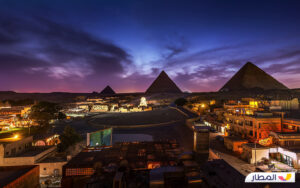
A Walk Through History: Ancient Egypt
Luxor: The Open-Air Museum
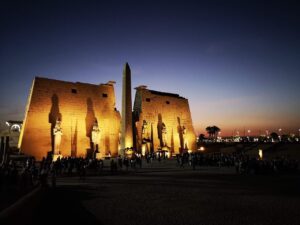
Aswan and the Temples of Nubia
The Vibrancy of Cairo
Sailing the Lifeline: The Nile River
Modern Experiences with Ancient Roots
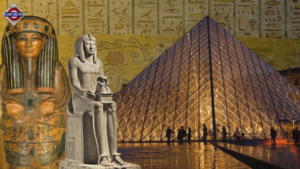
Tips for a Seamless Journey
Conclusion
Valley of the Kings & Luxor's Temples: Ancient Egypt Guide
Start an amazing journey through ancient Egypt’s world. The Valley of the Kings and Luxor’s Temples show the greatness of a long-lost time. This guide helps you explore the history, amazing buildings, and spiritual value of these sites. You’ll see the fascinating past of the pharaohs and their civilization.
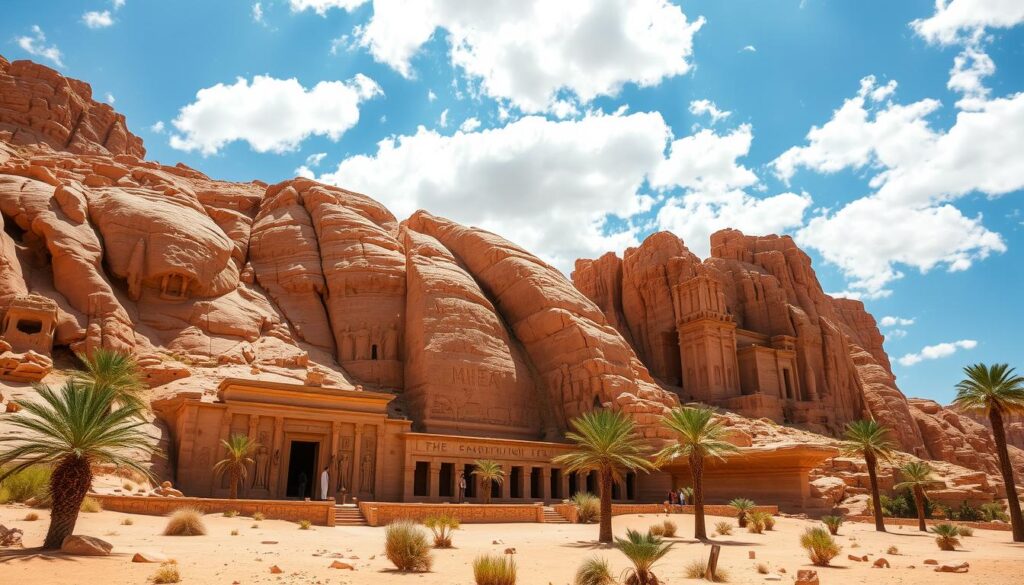
Key Takeaways
-
- Explore the enigmatic Valley of the Kings, home to the final resting places of powerful Egyptian pharaohs.
-
- Discover the architectural wonders of Luxor’s Temples, showcasing the pinnacle of ancient Egyptian religious and cultural achievements.
-
- Delve into the evolution of royal burial practices and the golden age of temple construction in ancient Egypt.
-
- Uncover the religious significance and spiritual importance of these legendary sites.
-
- Plan your visit to these captivating destinations, learning about the best times and essential tips for an unforgettable experience.
The Valley of the Kings and Luxor’s Temples: A Historical Overview
The Valley of the Kings and Luxor’s Temples are key parts of ancient Egypt’s history. They have captivated scholars and visitors for centuries. These sites show how burial practices and temple building evolved, shaping Egypt’s culture and religion.
Evolution of Royal Burial Practices
In Luxor, the Valley of the Kings was where pharaohs were laid to rest. It saw a change from pyramids to hidden tombs. This change showed the growing importance of the afterlife and protecting pharaohs’ legacies.
The Golden Age of Temple Construction
The temples in Luxor, like Karnak and Luxor Temples, show ancient Egypt’s skill in building. The Valley of the Kings and Luxor’s Temples saw a peak in temple building during the New Kingdom. Pharaohs spent a lot of resources and labor on these massive structures. These temples were not just for worship but also showed the power of the pharaohs.
Religious Significance in Ancient Egypt
The Valley of the Kings and Luxor’s Temples were deeply important in ancient Egypt. They were connected to the beliefs and rituals of the time. The tombs held pharaohs’ remains, and the temples were centers for religious events. The detailed hieroglyphics and symbols found there offer a glimpse into ancient Egyptian beliefs.
| Site | Significance | Key Features |
|---|---|---|
| Valley of the Kings | Royal burial site for New Kingdom pharaohs | Elaborate tombs, hidden entrances, sacred artifacts |
| Karnak Temple Complex | Largest religious site in ancient Egypt | Great Hypostyle Hall, sacred lakes, towering obelisks |
| Luxor Temple | Gateway to ancient Egyptian spirituality | Colossal statues, sphinx-lined avenues, religious festivals |
“The Valley of the Kings and Luxor’s Temples stand as timeless testaments to the ingenuity, spirituality, and cultural legacy of ancient Egypt.”
Inside the Valley of the Kings: Exploring Ancient Egyptian Tombs
Step into the Valley of the Kings, a place of ancient secrets. Here, the tombs of Egypt’s pharaohs await. Located near Luxor, it’s a site of grand burial chambers and tombs.
The walls of these tombs are painted with vivid scenes. They show the beliefs and rituals of the ancient Egyptian tombs. These paintings were made to help the pharaohs on their journey to the afterlife.
King Tutankhamun and Ramesses the Great are among those buried here. The discovery of Tutankhamun’s tomb in 1922 amazed the world. It sparked a new interest in pharaonic monuments. Ramesses the Great’s temple and statues show his lasting impact.

The designs and symbols in these ancient Egyptian tombs reveal much about the pharaohs’ beliefs. Visitors to the Valley of the Kings can explore this fascinating world. The pharaonic monuments and the tombs’ mysteries still captivate and inspire today.
Karnak Temple Complex: Marvel of Ancient Architecture
In the heart of Luxor, the Karnak Temple Complex shows the ancient Egyptians’ skill and faith. It’s one of the biggest religious sites globally, with a 2,000-year history.
The Great Hypostyle Hall
The Great Hypostyle Hall is at the complex’s core. It has huge columns that once held up the roof. The hall’s carvings and inscriptions give a peek into the temple’s grandeur and spiritual importance.
Sacred Lakes and Obelisks
The temple is surrounded by sacred lakes, key in ancient Egyptian rituals. The obelisks, symbols of Ra, show the ancient Egyptians’ architectural and spiritual achievements.
Religious Ceremonies and Festivals
The Karnak Temple Complex was a center for religious events. It hosted festivals like the Opet and Sed Festivals. These events celebrated Egyptian gods and were culturally and spiritually significant.
Visiting the Karnak Temple Complex is like stepping back in time. It offers a look into ancient Egypt’s history and architecture, showing the civilization’s grandeur and faith.
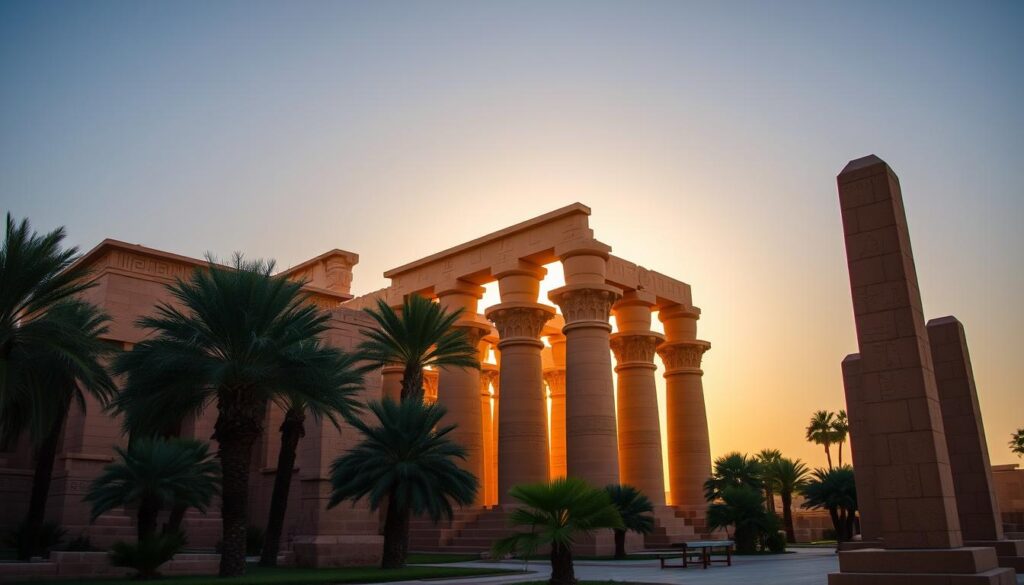
Luxor Temple: Gateway to Ancient Egyptian Spirituality
The Luxor Temple is in the heart of Luxor, along the Nile River. It shows the deep spiritual roots of ancient Egypt. Built over centuries, it gives us a peek into the beliefs and rituals of the pharaohs.
The temple’s design is special. It was made to match the sun’s path and the Nile’s floods. Its columns, reliefs, and obelisks were more than just structures. They were paths for divine energy.
The Opet Festival was a big deal here. It celebrated the union of the pharaoh with the gods. The god Amun-Ra’s statue was moved from Karnak to Luxor. The pharaoh was crowned, linking them to the divine.
| Architectural Features | Religious Significance |
|---|---|
| Towering Columns | Conduits for divine energy |
| Ornate Reliefs | Depictions of deities and rituals |
| Imposing Obelisks | Symbols of the sun god Ra |
The Luxor Temple reminds us of ancient Egypt’s deep spiritual beliefs. As we walk through, we feel like we’ve stepped back in time. We see the pharaonic monuments and imagine a world where heaven and earth were one.
“The Luxor Temple is more than just a architectural marvel; it is a gateway to the very heart of ancient Egyptian spirituality.”
Hidden Treasures: Notable Discoveries and Archaeological Findings
The Valley of the Kings and Luxor’s Temples are full of archaeological wonders and ancient Egyptian tombs. Many important discoveries have been made here. These have helped us learn more about the history and culture of this area.
Tutankhamun’s Tomb
The discovery of Tutankhamun’s tomb in 1922 is famous worldwide. Howard Carter, a British archaeologist, found it. It showed us how richly the ancient Egyptian pharaohs were buried.
The tomb was found almost perfectly preserved. It had many valuable artifacts. This made it one of the most important finds in history.
Recent Archaeological Breakthroughs
New discoveries keep coming from the Valley of the Kings and Luxor’s Temples. Thanks to archaeologists and researchers, we learn more about ancient Egypt. They find new tombs, discover unknown sarcophagi, and study ancient writings.
Preservation Efforts
These archaeological wonders and ancient Egyptian tombs attract visitors from everywhere. It’s important to keep them safe. Conservation work, using new technology and strict rules, helps protect these treasures for the future.
| Significant Archaeological Discoveries | Year of Discovery |
|---|---|
| Tutankhamun’s Tomb | 1922 |
| Sarcophagus of Amenhotep III | 2019 |
| Tomb of Userhat | 2021 |
| Tombs of the Nobles in Luxor | 2022 |
Planning Your Visit: Best Times and Essential Tips
Planning a trip to the Valley of the Kings and Luxor’s Temples is exciting. To make your visit unforgettable, choose the best times and follow these tips.
The best time to see these sites is from October to April. The weather is cooler, and there are fewer people. This makes it easier to enjoy the ancient wonders without the heat.
Being flexible with your plans is important. A guided tour can help you make the most of your time. Local guides offer deep insights into the history and culture of these sites.
| Recommended Experiences | Ideal Duration |
|---|---|
| Explore the Valley of the Kings | 2-3 hours |
| Visit the Karnak Temple Complex | 1-2 hours |
| Discover the Luxor Temple | 1-2 hours |
Remember to respect local customs and etiquette. Dress modestly and respect sacred areas. Always ask before taking photos. Also, think about where to stay and how to get around.
By following these tips, you’ll have a memorable trip to the the valley of the kings and luxor’s temples in ancient Egypt.
Conclusion
Our journey through the Valley of the Kings and Luxor’s Temples has left us in awe. These sites show the lasting legacy of ancient Egypt. They reveal the lives of pharaohs and the grand temples that were the heart of their culture.
It’s crucial to keep these ancient sites preserved and studied. They help us understand the past and value our cultural heritage. By doing so, we ensure these wonders continue to inspire and educate future generations.
We invite all curious travelers to visit these iconic places. See the Valley of the Kings and Luxor’s Temples for yourself. It’s a chance to connect with the history and spirit of the pharaohs.
FAQ
What is the significance of the Valley of the Kings and Luxor’s Temples in ancient Egyptian history?
The Valley of the Kings and Luxor’s Temples are key sites in Egypt. They show the peak of pharaonic monuments and the beliefs of ancient Egyptians. The Valley of the Kings was where pharaohs were buried. Luxor’s Temples were centers of spirituality and power.
What can visitors expect to see at the Valley of the Kings?
At the Valley of the Kings, visitors can see the tombs of famous pharaohs. The most famous is Tutankhamun’s tomb. These tombs have detailed paintings, hieroglyphics, and artifacts. They give a peek into the burial practices and beliefs of ancient royalty.
How does the Karnak Temple Complex showcase the architectural achievements of ancient Egyptians?
The Karnak Temple Complex is a showcase of ancient Egyptian architecture. It has the Great Hypostyle Hall with 134 massive columns. The complex also has sacred lakes, obelisks, and temples. It shows the Egyptians’ skill in engineering and their religious dedication.
What is the significance of Luxor Temple in ancient Egyptian spirituality?
Luxor Temple was a key religious site in ancient Egypt. It was a gateway to the divine and the site of coronation rituals. Its architecture, with colonnaded halls and statues, reflects the Egyptians’ spiritual beliefs and traditions.
What are some of the notable archaeological discoveries that have been made in the Valley of the Kings and Luxor’s Temples?
The most famous find is Tutankhamun’s tomb. It revealed treasures and insights into ancient burial practices. Recently, archaeologists have found new tombs and are working to preserve these sites.
When is the best time to visit the Valley of the Kings and Luxor’s Temples, and what tips can you offer for planning a successful trip?
The best time to visit is from October to April, when it’s cooler. Joining a guided tour can enhance your experience. Remember to respect local customs and stay hydrated and protected from the sun
4 min read